 Research Article
Research Article
Effect of Garment Wastes on Swell-Consolidation Characteristics of Expansive Soil
Md Mahmud Sazzad, Md Shariful Islam*, Monami and Miraz Ahamed
Department of Civil Engineering, RUET, Bangladesh
Md. Shariful Islam, Department of Civil Engineering, RUET, Bangladesh.
Received Date: March 18, 2019; Published Date: March 26, 2019
Abstract
Expansive soil is available throughout the world. In semi-arid country like Bangladesh, this type of soil is found almost everywhere. Expansive soil is considered to be problematic due to its high swelling potential. This type of soil exhibits large volumetric changes when its water content changes. This is highly detrimental to civil engineering infrastructures. This experimental study investigates the effect of the inclusion of garment wastes into expansive soil on its swell-consolidation characteristics. Due to the rapid growth of garment industries in Bangladesh, a huge amount of garment wastes is produced every year. The use of such waste materials to improve the swell-consolidation characteristics would be significant. To determine the effect of the inclusion of garment wastes into expansive soil, one dimensional swell-consolidation tests were conducted in the laboratory. Two types of expansive soil collected from Godagari, Rajshahi and Gazipur, Dhaka were used in the study. Various proportion of garment wastes by weight of soil (0.5%, 1%, and 2%) were mixed with the expansive soil and the samples were subjected to one dimensional swell-consolidation tests. The test results show that the inclusion of garment wastes has significant effect on the swell-consolidation characteristics of expansive soil. It is noticed that the inclusion of garment wastes decreases the heave, swelling potentials and vertical swelling pressures of expansive soil. Moreover, the coefficient of compressibility and the secondary compression index decrease with the increase of the inclusion of garment wastes into expansive soil.
Keywords:Expansive soil; Swell potential; Vertical swelling pressures; Secondary consolidation; Garment wastes
Introduction
Expansive clays are considered as a problematic due to high shrinkage and swelling potential. Expansive clays swell considerably when water is added to them and then shrink with the loss of water. Many civil constructions and foundations are subjected to large uplifting forces caused by swelling and shrinkage problems. These forces impact heaving, cracking and the breakup of both building foundation and slab-on-grade members. Expansive clays cover large parts of the United States, South America, Africa, Australia, India and a little portion of Bangladesh. There are little amount in research and investigation on swelling and shrinkage problems of expansive clay which are performed in Bangladesh. For Bangladesh it can be considered as a great significant data study due to its engineering significance, it has drawn attentions to many researchers and designers. Many innovative techniques are developed to counteract the problems posed by expansive soils by transformation of soil index properties with the addition of chemicals such as cement, fly ash, lime or combination of these, often alter the physical and chemical properties of the soil including the cementation of the soil particles. Especially use of lime or sand admixture has proved to have a great potential as an economical method for improving the geotechnical properties of expansive soils. These methods are quite effective in controlling the volumetric changes in expansive soils. Apart from the above techniques, geosynthetic inclusions as a technique of random reinforcement have also been found quite effective in controlling swelling and shrinkage [1]. Compacted expansive soils, reinforced with polypropylene fibres, have exhibited reduced tension cracking and controlled volumetric changes due to swelling and shrinkage [2]. Shen SL, et al. [3,4] observed that fibre inclusions increased the tensile strength. A combination of fly ash and polypropylene fibres has also been found to reduce the swelling and shrinkage characteristics of expansive soils [5-7]. Yilmaz I, et al. [8] observed that an increase in fiber content led to a reduction in the swelling potential of lime-stabilized clayey soil. Al-Muhaidib et al. [9] investigated the effect of two types of fibres (natural and synthetic) on the swelling properties of clayey soils. Jamsawang P [10] presented that the swell-consolidation characteristics of remoulded expansive clay specimens reinforced with randomly distributed nylon fiber. The secondary consolidation characteristics of both unreinforced and fiber-reinforced specimens also studied. It should be mentioned here that there are quite a few differences between the work done by [9].
In this paper, two types of soil samples been considered, and soil has been collected from two different locations of Bangladesh. One is Ghodagari in Rajshahi that is the north part of Bangladesh and another is Gazipur in Dhaka that is the east part of Bangladesh. The main objectives of this paper is to evaluate the swellingconsolidation and unconfined compression characteristic of fiberreinforced of two different remolded expansive soils. This paper presents that the effective in controlling the volumetric changes in two expansive soils by using polysynthetic (Garment waste). This fiber chooses due to locally available and economical in Bangladesh. This fiber also uses as a recycling purpose. It also presents the comparison the swell-consolidation and unconfined compression characteristics of two different types of remoulded expansive clays specimens reinforced with randomly disturbed of polysynthetic (Garment waste). The odeometer test (one-degree consolidation test) of both unreinforced and reinforced specimens were observed. It should be mentioned that there is a little bit difference between the work done by Jamsawang P [10]. The fibre content presented in Jamsawang P [10] ranges from 0% to 0.3% that time nylon fibre was considered whereas this paper presents that one type of fibre (polysynthetic (Garment waste) and the ranges from 0% to 2%. The aspect ratios(l/d) considered in this paper were only 15 which is similar to Jamsawang P [10].
Swelling potential and swelling pressure
The term swelling potential is generally used to indicate the amount of vertical swell (expressed as percentage of initial sample thickness) obtained under a particular surcharge (usually 1psi).

Where, Sp = swelling potential in percentage
δh = amount of vertical swell
h = initial height
The swelling pressure is defined as the vertical pressure required to prevent volume change of laterally confined sample when it is allowed to take in water. Percent expansion decreases with increase in confining pressure for a given initial moisture content and density.
Free swell of soil
This test tries to give a fair approximation of the degree of expansiveness of a given soil sample. In this test, 10cc of dry sample was passed NO-40 sieve into 100cc of distilled water. Then waited 24 hours until all the sample completely settles on the bottle of the cylinder. After that final volume of the sample was recorded.

Free swell method (Consolidation method)
In this test, an undisturbed soil sample is placed in a consolidometer and applied a normal load equal to 1psi. Then the sample is inundated and allowed it to swell. After the swelling is complete, load the sample in increments until the soil returns to its original volume. The pressure that corresponds to the original volume is the swelling pressure (Figure 1).
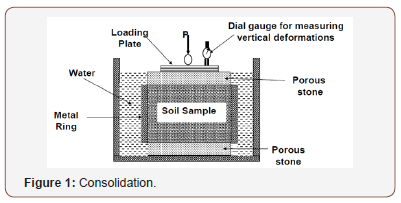
Test Materials
Two different types of expansive soil of different physical property were used and garment waste was added as a reinforcing element. Expansive soil samples were collected at a depth of 0.5 meter from the ground level of Godagary, Rajshahi and Gazipur, Dhaka of Bangladesh (Table 1).
Table 1: Index Properties of Expansive Soils.

Based on liquid limit and plasticity index the soil was classified as CL. Table-1 represent the index property of the soil. Garment waste which was used to reinforce the soil specimen was randomly oriented as reinforcement.
Test variable
Dry unit weight(γd) of the expansive soils were 19.57 kN/m3 (Godagary) and 19.45 KN/m3 (Gazipur). The fiber content (fc) used in this study was 0%,0.5%,1%,2% by the dry weight of soil.
Test conducted and quantities determined
To determine the heave, swell potential and the swelling pressure one dimensional swell-consolidation test were conducted in oedometer on remolded specimen in both unreinforced and garment fiber reinforced condition. And also, the secondary consolidation behavior of both conditions was studied. The swelling pressure (σvs) is determined from one dimensional swellconsolidation tests. σvs is determined from the e-log(σvs) curve as the pressure related to the initial void ratio (eo).
Test procedure
The consolidation ring dimension was 52mm in diameter and 20mm in height. The both unreinforced and reinforced sample were filled and uniformly compacted. The weight of fiber related to the chosen fiber content (fc) was thoroughly mixed with the expansive soil and uniformly compacted. Two porous stone was placed on the top and bottom of the soil sample. After that the sample was allowed to swell freely for 24 hours. After the equilibrium heave had been reached, the samples were subjected to compression by increasing the compressive loads on the specimen. The samples were then allowed to undergo consolidation under each load increment for 24 h. From the result e-log σvs curve is plotted and swelling pressure corresponding to the initial void ratio was determined.
Result and Discussion
(Figures 1,2) Figures 2 and 3 gives the results of consolidation tests on increasing fiber contents. A remarkable improvement can be observed on the compressibility of the soil which has been mixed with 1% garment waste.
(Figures 4) Figure 4 illustrates that the heave decreased with the increased of percentage of garments waste (Figures 5-7).
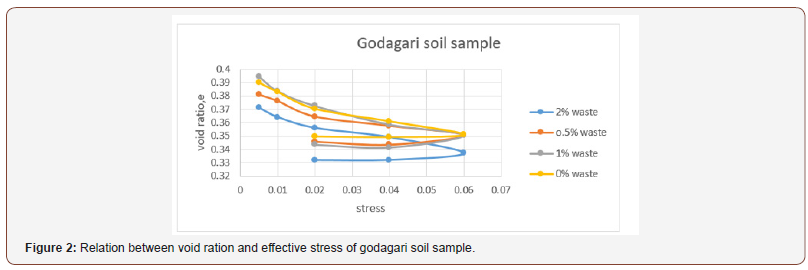


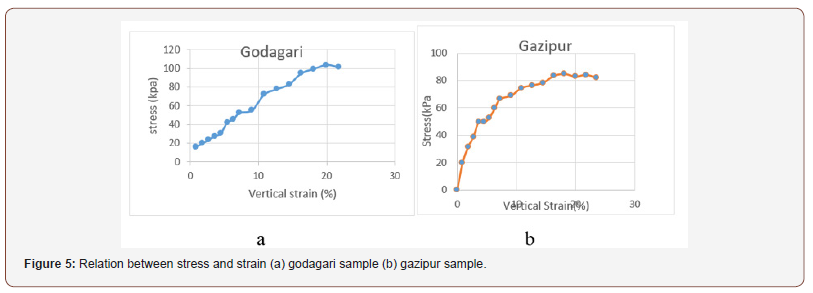
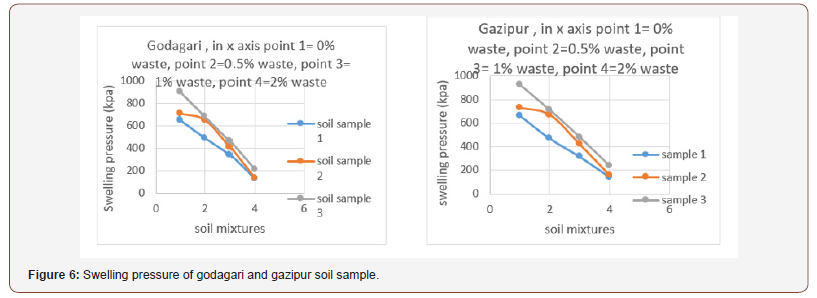
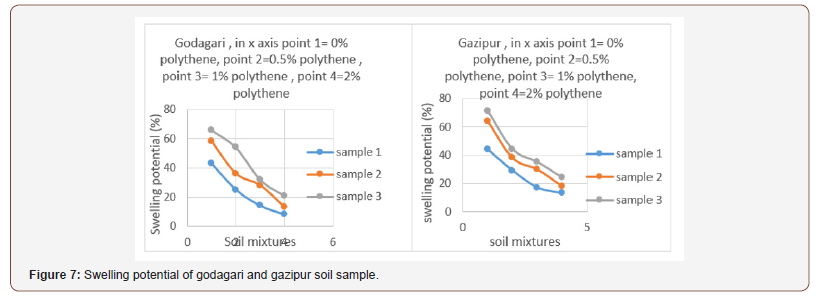
Conclusion
In this paper, an experimental study is conducted so that to determine the improvement in swelling characteristic of expansive soils. In laboratory two different types of expensive soils are used and tested in various sites. The soils are mixed with garments waste (0 % to 2%) and to determine the void ratio, stress-strain, swelling pressure, swelling potential, percentage of heave and so on. The heave decreased with the increased of percentage of garments waste. It can be conducted that, there is a potential for use of garment waste fiber to reinforce expansive soil.
Acknowledgement
None.
Conflict of Interest
No conflict of interest.
References
- Viswanadham BVS, Phanikumar BR, Mukherjee RV (2009) Swelling behaviour of a geofiber-reinforced expansive soil. Geotextiles and Geomembranes 27(1): 73-76.
- Komarnik A, David D (1969) Prediction of Swelling Pressure of Clays. ASCE Proceedings SM and FE Division 95(1): 209-226.
- Bergado DT, Anderson LR, Miura N, Balasubramaniam AS (1996) Soft Ground Improvement in Lowland and Other Environments. ASCE Press, New York, USA.
- Shen SL, Han J, Du YJ (2008) Deep mixing induced property changes in surrounding sensitive marine clays. Geotech. Geoenviron. Eng. 134 (6): 845-854.
- Cokca E (2001) Use of class C-fly ashes for the stabilization of an expansive soils. Geotech. Geoenviron. Eng. 127 (7): 568-573.
- Azam S, Wilson GW (2006) Volume change behavior of a fissured expansive clay containing anhydrous calcium sulfate. In: Proceedings of the Fourth International Conference on Unsaturated Soils. ASCE Press, pp. 906-915.
- Al-Rawas AA, Goosen MFA (2006) Expensive Soils: Recent Advances in Characterization and Treatment. Taylor and Francis, London, UK.
- Yilmaz I, Civelekoglu I (2009) Gypsum: an additive for stabilization of swelling clay soils. Appl. Clay Sci. 44(1): 166–172.
- Al-Muhaidib A (2003) Characteristics of Expansive Soil in the Kingdom of Saudi Arabia. Journal of King Saud University (Engineering Sciences) 16(1): 1-34.
- Jamsawang P, Yoobanpot N, Thanasisathit N, Voottipruex P, Jongpradist P (2016) Three-dimensional numerical analysis of a DCM columnsupported highway embankment. Comput. Geotech 72: 42-56.
- Byer JG (1980) Treatment of Expansive Clay Canal Lining. Proceeding of the 4th International Conference on Expansive Soils, Denver, USA.
- Chen FH, Ma GS (1987) Swelling and shrinkage behavior of expansive clays. Proceedings of 6th International Conference on Expansive Soils, New Delhi, India, pp. 127-129.
- Datye KR (1987) Linings and Stabilization of Slopes for Channels in Black Cotton Soil. Proceedings of the 6th International Conference on Expansive Soils, Delhi, India,626-629.
- Horpibulsuk S, Chinkulkijniwat A, Cholphatsorn A, Suebsuk J, Liu MD (2012) Consolidation behavior of soil cement column improved ground. Comput. Geotech 43: 37–50.
- Leroueil S, Vaughan PR (1990) The general and congruent effects of structure in natural soils and weak rocks, Géotechnique 40: 467-488.
-
Md Shariful Islam, Md Mahmud Sazzad, Monami, Miraz Ahamed. Effect of Garment Wastes on Swell-Consolidation Characteristics of Expansive Soil. Cur Trends Civil & Struct Eng. 1(5): 2019. CTCSE.MS.ID.000525.
-
Swell consolidation, Infrastructures, Expansive soil, Swell potential, Vertical swelling pressures, Secondary consolidation, Garment wastes, Consolidation
-

This work is licensed under a Creative Commons Attribution-NonCommercial 4.0 International License.






